5 Steps to Master Online Market Research for Analysts

5 Steps to Master Online Market Research for Analysts
Overview
The article examines the essential steps analysts can take to master online market research, underscoring the significance of systematic data collection and analysis in understanding buyer behavior and industry trends. By establishing clear research objectives, analysts can effectively gather data using various online tools. This systematic approach not only facilitates comprehensive data collection but also enhances the ability to derive actionable insights through analytical techniques. Such insights are crucial for making informed strategic decisions in a competitive market.
What methods can analysts employ to ensure they are gathering the most relevant data? This article details various approaches, illustrating how each contributes to a deeper understanding of market dynamics. By emphasizing the importance of tailoring research objectives, analysts can align their data collection efforts with specific business goals, ultimately leading to more effective strategies. The benefits of this meticulous approach are clear: informed decision-making that can significantly impact a company's competitive edge.
In conclusion, mastering online market research is not merely about collecting data; it is about transforming that data into strategic advantages. Analysts who embrace these systematic methods will find themselves better equipped to navigate the complexities of the market, ensuring that their organizations remain responsive and proactive in the face of changing trends.
Introduction
In an increasingly digital landscape, the ability to conduct effective online market research has become a vital skill for analysts aiming to stay ahead of the competition. This guide delves into the essential steps that empower professionals to harness digital tools for gathering and analyzing consumer insights, ultimately driving strategic decision-making.
However, with a plethora of methods and data sources available, how can analysts ensure they are extracting the most relevant and actionable insights to inform their strategies? By understanding the features of these digital tools, analysts can leverage their advantages to enhance their research processes. This not only leads to more informed strategies but also positions analysts to respond effectively to market changes.
Define Online Market Research
Online market research involves the systematic collection, examination, and interpretation of information related to buyer behavior and industry trends through digital platforms. This process employs a variety of online tools, such as surveys, social media analytics, and web analytics, for online market research to gather valuable insights about target audiences, competitors, and industry dynamics. By utilizing these resources, researchers can reveal insights into consumer demands and preferences, which are essential for directing strategic decision-making.
Specialists highlight that grasping the subtleties of online analysis is essential for analysts. As Kelsey Sullivan observes, "Obtaining a clear understanding of your industry is essential for business success." This sentiment is echoed by the Bastion Agency, which emphasizes that "digital qualitative inquiry eliminates geographic barriers and enables brands to reach a diverse audience without the logistical constraints of in-person focus groups."
Successful instances of online market research demonstrate its significance for companies in 2025. For instance, brands utilizing predictive analytics can forecast consumer behavior, allowing them to adapt strategies swiftly. This agility is crucial in a rapidly evolving business environment, where real-time insights enable companies to respond quickly to consumer expectations. As noted, "real-time insights allow companies to respond promptly to consumer expectations, such as altering a product or marketing message based on initial reception."
Furthermore, with 61% of marketers recognizing the creation of traffic and leads as their primary challenge, online market research becomes an essential tool in addressing this issue. It offers a variety of tools that simplify the understanding of audiences and help companies stay ahead of trends.
In summary, online data analysis is not merely an instrument but an essential element for analysts and companies striving to succeed in a progressively data-oriented world. It empowers organizations to make informed decisions, ensuring they remain competitive and relevant in their respective markets.
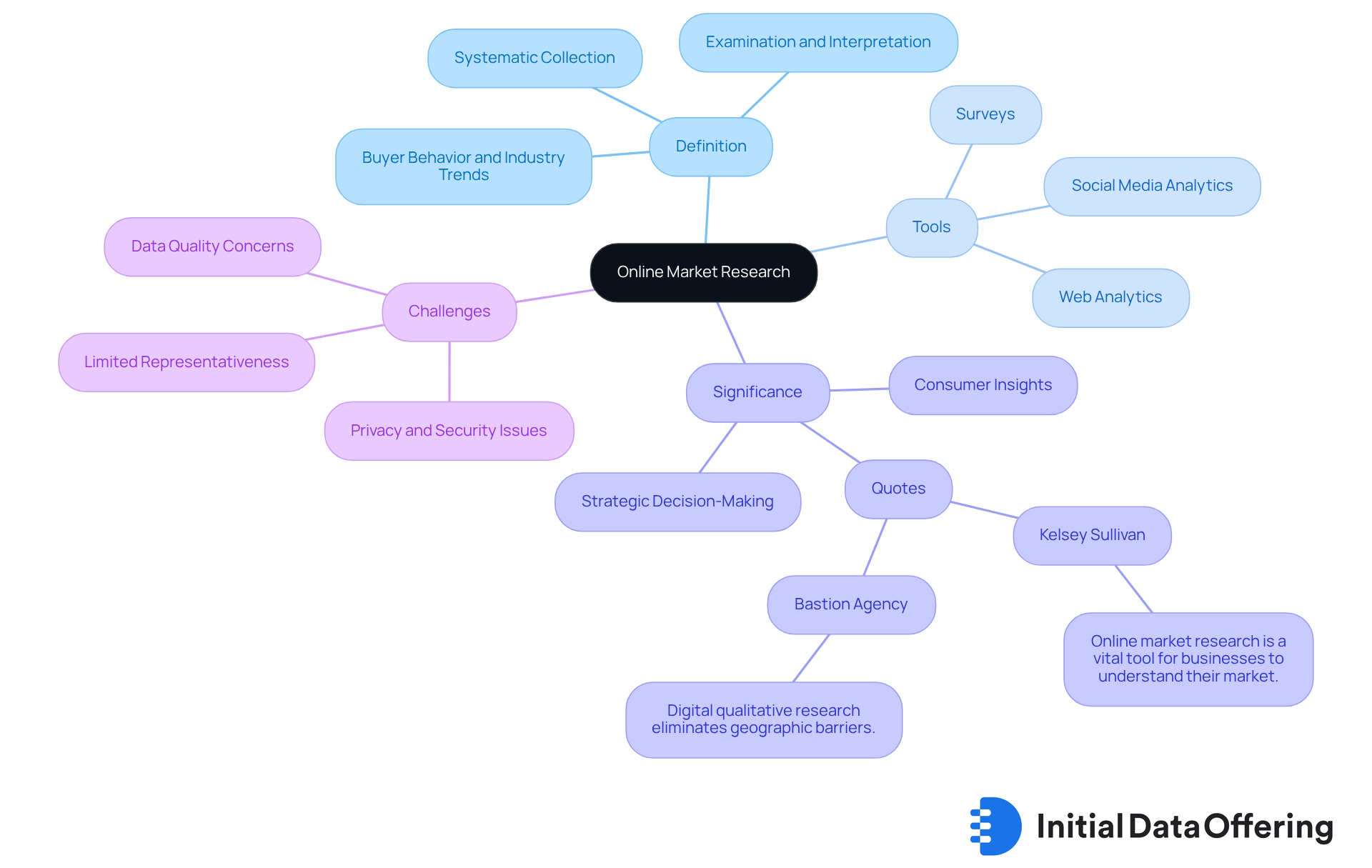
Identify Types of Market Research
Market analysis can be broadly categorized into two main types: primary studies and online market research. Primary investigation involves the collection of original data directly from sources, such as surveys, interviews, and focus groups. This customized approach provides direct insights tailored to specific inquiries via online market research. For instance, a recent survey indicated that approximately 70% of companies utilize fundamental investigation techniques to gather practical insights aligned with their requirements. Understanding target demographics is crucial for online market research, illustrated by the fact that 20% of Gen Z and 30% of Millennials are pet owners, which underscores the necessity for focused analysis in the pet industry.
Conversely, online market research entails examining existing data collected by others, such as industry reports, academic studies, and online databases. This method allows experts to leverage previously gathered information, saving time and resources while still providing valuable context. For example, the Other Services segment in the pet industry is valued at $13.0 billion, illustrating how secondary analysis can yield essential insights into the sector.
Grasping these categories empowers evaluators to select the appropriate method based on their objectives and available resources. Original investigations are often more resource-intensive but deliver targeted insights, whereas secondary analysis is generally quicker and more cost-effective, making it a vital tool for comprehensive industry evaluation. By effectively integrating both approaches, professionals can enhance their findings through online market research and facilitate informed decision-making. As industry leaders emphasize, employing a combination of both primary and secondary investigation techniques is essential for gaining a competitive edge in market analysis.
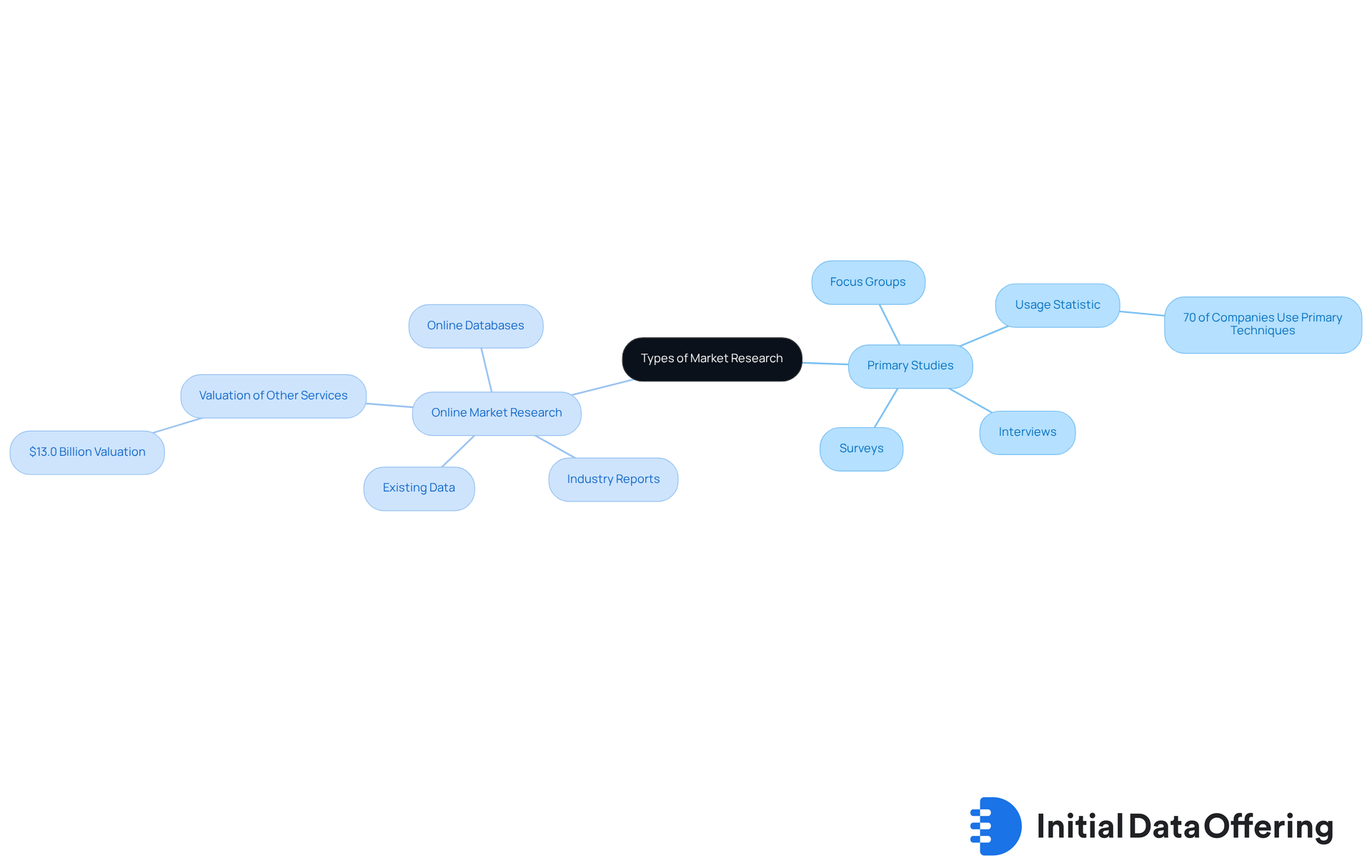
Establish Research Objectives
To establish investigation goals, specialists should begin by identifying the primary inquiries they wish to address. These questions must be specific, measurable, achievable, relevant, and time-bound (SMART). For instance, an objective could be to ascertain consumer preferences for a new product within a specific demographic. By clearly defining these objectives, analysts can formulate a focused study plan that effectively addresses the most pressing business needs and guides the data collection process.
As Nathalie Pozo, a Marketing and Communication Director, states, 'Defining clear objectives is the first step to a successful research study.' Furthermore, online market research reveals underserved markets and unexplored segments, underscoring the significance of setting clear objectives to identify market opportunities. Without a defined goal, it becomes easy to become overwhelmed by an abundance of information, losing sight of what details are truly pertinent to the issue at hand.
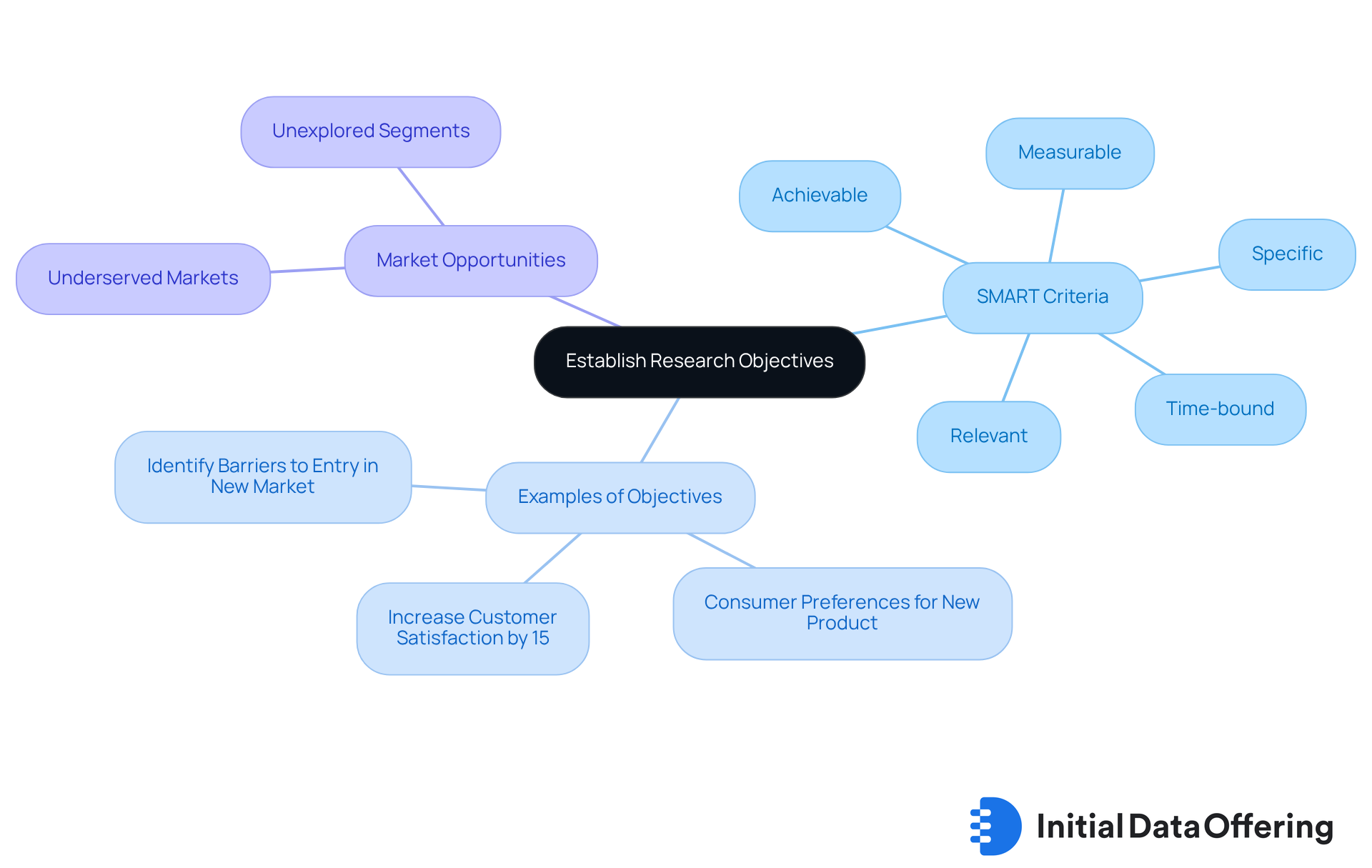
Gather Data Using Various Methods
Analysts can leverage a variety of methods for online market research to gather data effectively, including online surveys, social media listening, web analytics, and competitor analysis.
-
Online surveys are a powerful tool for collecting targeted responses, distributed via email or social media. In 2025, SMS surveys are projected to achieve response rates of 40-50%, while in-app surveys typically yield 20-30% participation. This underscores the effectiveness of immediate feedback mechanisms. The typical survey response rate across all channels in 2025 is 33%, offering a standard for evaluators to contemplate when assessing their own survey strategies.
-
Social media listening tools play a crucial role in tracking consumer sentiment and trends by analyzing conversations surrounding specific topics or brands. For instance, platforms such as Talkwalker and Brandwatch offer sophisticated features for identifying logos and sentiments across millions of sources. This provides insights into brand perception and industry dynamics, allowing analysts to understand the broader market context.
-
Web analytics further enhance understanding by providing insights into user behavior on websites. This enables researchers to see how consumers engage with digital content. Tools like Hotjar and SEMrush can be particularly useful for optimizing user experience and tailoring marketing strategies, thus improving overall engagement and conversion rates.
-
Additionally, competitor analysis involves scrutinizing competitors' strategies and performance to identify market gaps and opportunities. Tools such as Crayon allow real-time monitoring of competitor activities, assisting professionals in staying ahead in a competitive environment.
By utilizing a blend of these techniques, researchers can ensure that online market research guarantees a thorough and subtle information gathering process that promotes informed decision-making. How might these methods be integrated into your own research strategies?
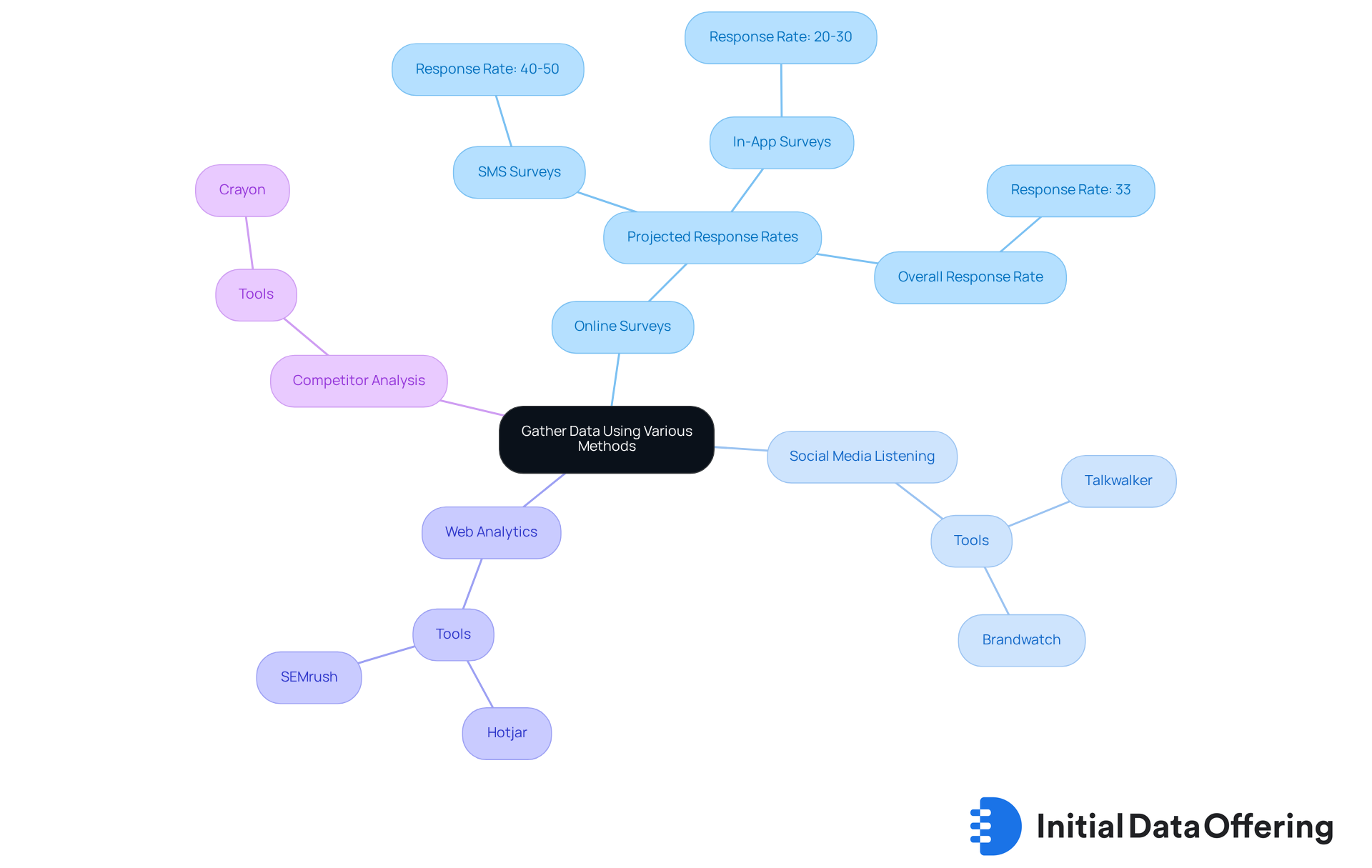
Analyze Data for Insights
After gathering information, analysts should employ a variety of analytical techniques to derive meaningful insights. This encompasses:
- Statistical examination
- Trend analysis
- Information visualization
Statistical analysis uncovers patterns and correlations within the data, while trend analysis reveals changes over time. Data visualization tools, such as bar charts, pie charts, and heatmaps, are essential for effectively communicating findings to stakeholders, transforming complex information into accessible visuals. For instance, visual representations can emphasize significant patterns in customer behavior, allowing researchers to pinpoint opportunities for growth and enhancement.
According to Statista, companies that skillfully utilize visual representation in digital marketing experience a 44% rise in engagement metrics. By synthesizing these insights, analysts can deliver actionable recommendations that align with research objectives, ultimately facilitating informed decision-making and strategic planning. Furthermore, as mentioned by Deloitte, companies that adhere to current trends in analytics can enhance agent productivity by as much as 130%. Effective information visualization not only improves comprehension but also promotes collaboration among teams, ensuring that insights are shared and utilized across departments.
However, analysts should also be aware of potential challenges, such as poor data quality and the complexity of analysis techniques, which can hinder effective data visualization.
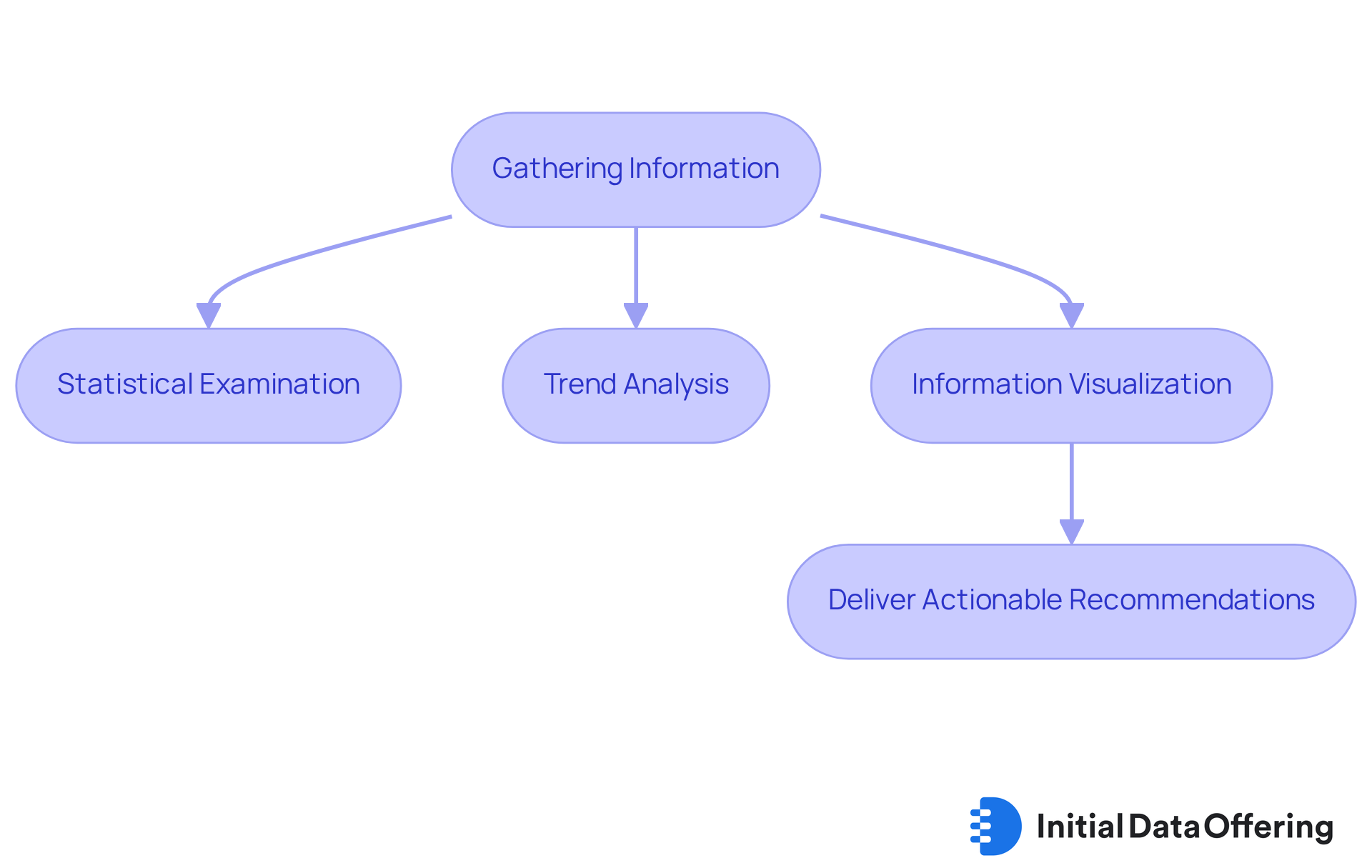
Conclusion
Online market research is a pivotal strategy for analysts aiming to navigate the complexities of consumer behavior and industry trends. By employing a systematic approach to data collection and analysis, this method reveals valuable insights and empowers organizations to make informed decisions that enhance their competitive edge.
This article explores various facets of online market research, including:
- The definition and types of research methods
- The importance of establishing clear research objectives
- Effective data gathering techniques
- The analytical processes that transform raw data into actionable insights
Each step emphasizes the need for a structured approach, highlighting tools and strategies that lead to successful outcomes in an increasingly data-driven landscape.
Ultimately, mastering online market research is essential for analysts who aspire to stay ahead in their fields. By embracing these practices, organizations can better understand their target audiences, identify market opportunities, and adapt swiftly to changing consumer expectations. The insights gained from comprehensive market research not only inform strategic planning but also foster innovation, ensuring that businesses remain relevant and competitive in their industries.
Frequently Asked Questions
What is online market research?
Online market research is the systematic collection, examination, and interpretation of information related to buyer behavior and industry trends through digital platforms. It utilizes various online tools, such as surveys and social media analytics, to gather insights about target audiences and competitors.
Why is understanding online market research important for analysts?
Understanding online market research is essential for analysts as it helps them grasp the subtleties of their industry, which is crucial for business success. It enables them to gather valuable insights that direct strategic decision-making.
How does online market research benefit companies?
Online market research allows companies to gain real-time insights into consumer demands and preferences, helping them adapt strategies swiftly in a rapidly evolving business environment. It also helps address challenges such as creating traffic and leads.
What are the two main types of market research?
The two main types of market research are primary studies and online market research. Primary studies involve collecting original data directly from sources, while online market research examines existing data collected by others.
What is the difference between primary studies and online market research?
Primary studies involve gathering original data through surveys, interviews, and focus groups, providing tailored insights. In contrast, online market research leverages existing data from industry reports and databases, saving time and resources.
How can understanding target demographics enhance online market research?
Understanding target demographics is crucial as it allows for focused analysis. For example, knowing that a significant percentage of Gen Z and Millennials are pet owners can guide research efforts in the pet industry.
What is the value of combining primary and secondary research methods?
Combining primary and secondary research methods enhances findings and provides a comprehensive view of the market. Primary research delivers targeted insights, while secondary research is quicker and more cost-effective, making both approaches vital for informed decision-making.